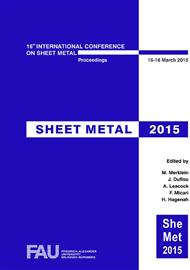p.435
p.443
p.451
p.459
p.469
p.477
p.485
p.493
p.501
Development of a Testing Method for the Identification of Friction Coefficients for Numerical Modeling of the Shear-Clinching Process
Abstract:
Global competition as well as social and scientific megatrends strongly influence the modern car manufacturing industry. One of the most important approaches is the implementation of lightweight constructions. Therefore, the usage of high performance materials with tailored properties gains importance. For safety-relevant components such as automotive passenger cells it is necessary to minimize deformation to reduce the risk of injury for the vehicle occupants during a car accident. Thus, hot stamped high-strength steels have been established. High-strength and low formability of this kind of materials represent new challenges for joining technologies. One possibility to join high-strength steels is the newly developed shear-clinching technology. Due to the use of a combined cutting and joining process, the connection of dissimilar materials with high difference in strength and formability can be achieved. Further research to ensure process reliability and to improve the strength of the joint is required. One possible approach for this is the numerical investigation of the material flow during the joining process. Therefore, the definition of process parameters for the finite element model is necessary. A big impact on the quality of the results has the accuracy of the used friction values. As established testing methods are not suitable for modeling the rather complex tribological system between the joining partners of the shear-clinching process, an innovative testing method is needed. Studies in the field of sheet-bulk metal forming already demonstrated the applicability of the ring compression test for sheet metals. This paper presents a concept for the adaption of the ring compression test to the specific needs of the investigated shear-clinching process. The numerical identification of the friction coefficients is validated by experimental data and first results are qualified by experimental and simulative shear-clinching joints.
Info:
Periodical:
Pages:
469-476
Citation:
Online since:
March 2015
Keywords:
Price:
Сopyright:
© 2015 Trans Tech Publications Ltd. All Rights Reserved
Share:
Citation:


